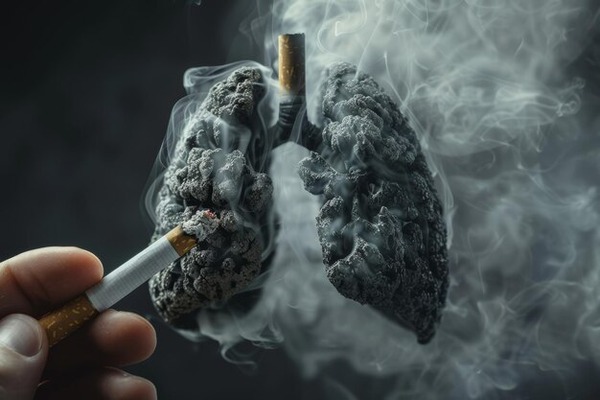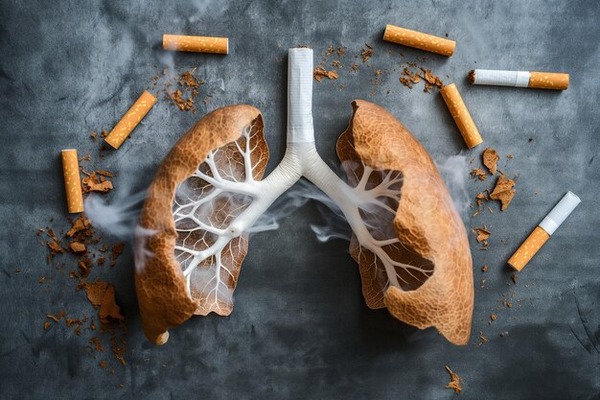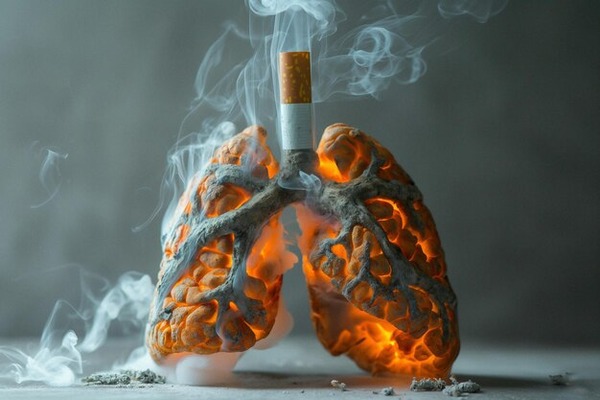Cigarette smoking has long been recognized as a major public health concern, contributing to numerous detrimental effects on the respiratory system and overall well-being. Smoking tobacco components are
- Nicotine: A highly addictive stimulant found in tobacco that affects the brain and central nervous system.
- Tar: A mixture of chemicals that forms a sticky residue in the lungs, contributing to various health problems.
- Carbon Monoxide: A poisonous gas present in tobacco smoke that interferes with the body’s ability to transport oxygen.
The human lungs contain approximately 500 million small air sacs known as alveoli. These structures play a crucial role in extracting oxygen from the inhaled air and expelling carbon dioxide during exhalation. Unfortunately, smoking poses a threat to these air sacs as it harms the cells lining them, leading to their destruction.
The harm to alveoli compounds over time, exacerbates the issue. As lung tissue undergoes damage, it undergoes fibrosis, resulting in increased difficulty for individuals to fully expand their lungs with each breath. The reduced lung tissue and limited expansion result in diminished oxygen reaching various parts of the body. This gradual deterioration often goes unnoticed until individuals experience a sensation of breathlessness due to cigarette smoking.
INTRODUCTION TO LUNG DISEASES
Lung disease encompasses any condition in the lungs that hinders their normal functioning. There are three primary categories of lung disease:
Airway diseases — The conditions that impact the tubes (airways) responsible for transporting oxygen and other gases to and from the lungs. Typically, these diseases lead to a constriction or obstruction of the airways. Examples of airway diseases include asthma, chronic obstructive pulmonary disease (COPD), bronchiolitis, and bronchiectasis
Lung tissue diseases — Structural lung tissue diseases specifically target the architecture of the lungs. Examples of such conditions include pulmonary fibrosis and sarcoidosis.
Lung circulation diseases — Diseases that impact the blood vessels within the lungs are characterized by clotting, scarring, or inflammation of these vessels. Pulmonary hypertension is an example of a lung circulation disease resulting from vascular complications.
Common diseases caused by smoking are chronic obstructive pulmonary disease (COPD), chronic bronchitis, emphysema, and most importantly lung cancer.
Chronic bronchitis
Chronic bronchitis is a form of chronic obstructive pulmonary disease (COPD) distinguished by the ongoing inflammation of the airways in the lungs, known as bronchi.
The inflammation causes an overproduction of mucus, as well as a stiffening and narrowing of the airways. This makes it difficult for air to flow in and out of your lungs. Smoking cigarette irritates and damages the lungs, leading to inflamed and narrowed airways. By the time, this can cause permanent damage.
Symptoms of chronic bronchitis may include:
- Cough
- Coughing up mucus
- Wheezing
- Chest discomfort or tightness
- Shortness of breath
- Crackling sounds while breathing
More severe effects when the condition worsens include: - The bluish discoloration of the lips, fingernails, and skin is a result of diminished oxygen levels in the blood.
- Swollen Feet
- Heart Failure

Emphysema
Emphysema, another form of chronic obstructive pulmonary disease (COPD), leads to the deterioration of the air sacs (alveoli) in the lungs. This condition causes a loss of elasticity in the air sacs, making it challenging for them to expand and contract as needed.
The consequence of emphysema includes difficulties in breathing, especially a diminished capacity to exhale. This condition leads to the entrapment of air in the lungs, manifesting as symptoms such as wheezing, shortness of breath, and a persistent cough.
Long-term exposure to cigarette smoke or other irritants is a common cause of emphysema. Continued smoking cigarette following a diagnosis can significantly exacerbate the condition by intensifying inflammation and causing additional damage to the air sacs.
The symptoms of emphysema include:
- Shortness of breath
- Persistent coughing
- Excessive mucus
- Wheezing
- Chest tightness
- Decreased appetite
- Fatigue and weakness
- Bluish discoloration of the lips or fingernail beds indicating a reduced oxygen level in the blood.
Lung cancer
Lung cancer is the result of abnormal and uncontrolled cell division in the tissues of the lungs. Lung cancer is responsible for 21% of all cancer deaths and is the leading cause of cancer deaths in the United States.
Lung cancer includes a wide range of symptoms including:
- Persistent cough, which may contain blood
- Chest pain
- Hoarseness
- Shortness of breath
- Wheezing
- Loss of appetite and weight loss
- Fatigue and weakness
- Recurring lung infections, like pneumonia or bronchitis
- Persistent fatigue
- Anemia
Smoking cigarette is the number one risk factor for lung cancer, and it significantly worsens its progression. Smoking induces chronic irritation and inflammation, increasing the likelihood of precancerous cells progressing to cancer.
In addition, the chemicals in cigarette smoke can damage the DNA in your lung cells and increase the risk of mutations.
HOW TO QUIT SMOKING
Quitting smoking cigarettes can be very hard. These tips can help you quit:
- Reflect on your reasons for wanting to quit smoking and create a list of motivations.
• Establish a quit date, choosing a time with minimal stress if possible.
• Seek support and encouragement from family, friends, and coworkers. - If you’re not already active, gradually increase your physical activity to improve your overall health.
- Prioritize sufficient sleep each night and adopt a healthy diet, along with exercise, to better cope with the quitting process.
• Consider joining a smoking cessation program or a support group, as most communities offer these resources.
Quitting smoking can help improve lung function—and it doesn’t take a lot of time to see positive changes, including:
- Within one month to a year after quitting, the frequency of coughing and the sensation of breathlessness diminish. The cilia, the hair-like structures resembling brooms that facilitate the removal of mucus from the lungs, commence the process of self-repair
- A decade after ceasing smoking, the likelihood of developing lung cancer is halved compared to that of an individual who continues to smoke. Moreover, the risk of other cancers, such as mouth, throat, and bladder, also experiences a notable reduction.

Summary:
To sum up, the exploration of smoking cigarettes and its catastrophic effects on lung health serves as both a serious alert and an appeal for action. The persistent black shadow of lung illnesses generated by continued smoking serves as a constant reminder of the decisions we make and the implications they have. But with all of these difficult there is cause for hope. Every choice we make to abstain from or stop smoking illuminates a small part of this darkness and moves us closer to a better, healthier future for our communities and ourselves.




